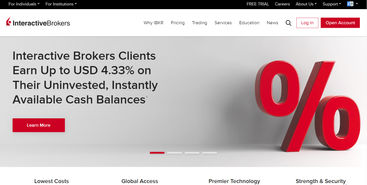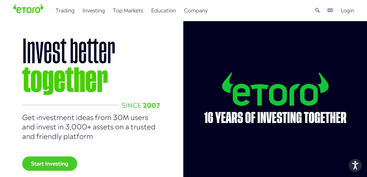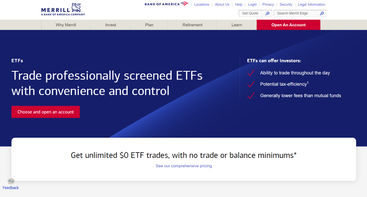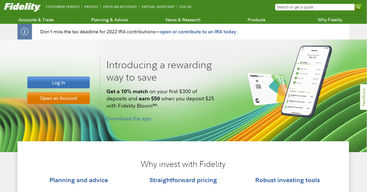By providing instant diversification for your portfolio, investing in ETFs can amplify the potential of any investor, novice or seasoned alike. We scoped the market to curate a list of the best ETF trading platforms available for US investors.
From eToro's automated features and easy-to-use interface to IG's Smart Portfolio, each offers unique solutions to streamline your trading experience.
Leading ETF Brokers: Top Picks
| Name | Score | Visit | Disclaimer | |
|---|---|---|---|---|
 | 9.1 | Visitinteractivebrokers.com | ||
 | 8.7 | Visitetoro.com | eToro is a multi-asset investment platform. The value of your investments may go up or down. Your capital is at risk. | |
 | 9.8 | Visitplus500 | CFDs are complex instruments and come with a high risk of losing money rapidly due to leverage. 80% of retail investor accounts lose money when trading CFDs with this provider. You should consider whether you can afford to take the high risk of losing your money. CFD Service. FCA (FRN 509909). | |
 | 4IG | 8.9 | Visitig.com | Spread bets and CFDs are complex instruments and come with a high risk of losing money rapidly due to leverage. 70% of retail investor accounts lose money when trading spread bets and CFDs with this provider. You should consider whether you understand how spread bets and CFDs work, and whether you can afford to take the high risk of losing your money. |
The Best ETF Trading Platforms at a Glance
Overall best platform for trading ETFs - eToro
Best ETF platform with smart portfolio - IG
Best ETF platform with educational material - Merrill Edge
ETF platform with the best screener - Interactive Brokers
Best ETF platform with portfolio analysis functionality - Charles Schwab
Best ETF platform with fractional shares - Fidelity
Best ETF platform for beginners - Robinhood
Best platform for ETF variety - Vanguard
Best ETF platform with low costs - Ally
Best ETF platform for experienced traders - TD Ameritrade
Top 10 ETF Trading Platforms Reviewed
Below listed are the small reviews of the top 10 ETF brokers available across the United States.

IBKR is favored globally, and especially among experienced traders, for its far-reaching research and analysis capabilities. Its ETF screener covers over 150 global markets and is highly customizable.
Being one of the best ETF platforms in the market, the platform also includes over 45 preset screeners for those who prefer it over creating a custom one, and it’s possible to create more than one screener for different purposes. It’s worth noting that the outlay of IBKR along with the sheer number of moving parts may overwhelm a less experienced trader.
Besides impeccable research tools, Interactive Brokers also features an exceptional range of ETFs of over 13,000 and allows traders to give algorithmic ETF trading a go through ScaleTrader.

Bringing together commission-free trading, a platform with top-notch usability, and impeccable automated features, eToro takes the lead among the best ETF brokers. When you start to trade EFTs the broker compensates for the lack of ETF variety with impeccable trading technology with a great focus on automation.
Its exemplary CopyTrader feature along with Smart Portfolio allocation and social trading platform appeals to traders with varying levels of knowledge and those who’d like a hands-off experience.
The trading mechanism is supported by advanced charting capabilities provided by ProCharts, which allows assessment of historical performance and at-a-glance comparison, and a news feed that comes with subscriptions to leading publications like the Financial Times or Wall Street Journal.
With exposure to over 5400 global ETFs, advanced trading technologies, and relatively low-cost services, IG manages to find a harmony between quality and accessibility. When you consider trading ETFs, one of its outstanding features is the Smart Portfolio capability, which allows selecting from numerous portfolios designed by BlackRock and managed by IG based on the investor’s long-term goals and risk appetite allowing room for further customization.
IG is by no means the cheapest platform for ETF trading, yet its charges are capped fairly reasonably when compared to other wealth management systems with comparable access to expert guidance.

Merrill Edge features a sleek and intuitive platform with straightforward trading mechanisms for ETF trading, topped up with two extensive ETF screeners with different sets of parameters, one of which is created by its parent company Merrill Lynch.
One of its exceptional features is the far-reaching educational department. The section contains valuable content for both novice and experienced traders alike and walks investors through all stages of ETF trading.
Merrill Lynch is also a subsidiary of Bank of America and both outfits are fully integrated. This means that BoA clients can access all their finances through a single platform and enjoy a seamless banking and ETF investing experience. Trade ETFs with Merrill Edge for the full experience.
With over $7 trillion in client funds under management, the US-based financial services company is one of the major global players. The platform combines commission-free ETF trading with outstanding research capabilities, and it particularly shines in tools for portfolio analysis and allocation that are well-rounded.
The personalized portfolio builder helps traders design a diversified portfolio from bottom to top based on their risk tolerance and long-term goals. Those who are looking for a hands-free experience with one of the best ETF platforms in the market can opt for Intelligent Portfolio which skews a robo-advisor to build, monitor, and rebalance ETF portfolios automatically.

As one of the largest brokerages across the country, Fidelity has been exceptional in keeping their charges low and producing top-tier products celebrated by traders with varying levels of experience. In the spirit of lowering the entry barrier even further down, the platform has launched fractional shares with which traders can buy ETFs based on dollar amount, rather than whole shares. So technically, it is possible to buy a fraction of a share for as little as $1.
Fidelity features a solid ETF research tool. The ETF and mutual fund screener supports close to 100 parameters to narrow down the search and allows traders to search for ETFs by desired security.

A pioneer in commission-free trading, Robinhood is known for mainstreaming retail investing. The outfit recently steered its focus on enriching the educational materials included in its products; when combined with exemplary low costs and an easy-to-navigate interface, it has become even more suitable for traders with less experience.
It's worth noting that the reach of Robinhood’s trading instruments and analysis tools may not be very suitable for an advanced trader, but the lack of many moving parts makes it so much easier for novice traders to understand the ins and outs of the trade.

Vanguard has established itself as a firm believer in long-term passive investing and naturally has offerings geared towards that direction rather than growth-oriented, short-term, or active investing.
The platform is straightforward and resourceful for value ETF investors with a wealth of educational material on the investment philosophy, tools for retirement planning, and low-cost services serving a buy-and-hold strategy. Similarly, it lacks crucial technical analysis tools like charting or research capabilities that active traders heavily rely on. Vanguard is considered to be one of the best ETF platforms in the market.
Traders can narrow down their search among 1800 ETFs with filters including risk grade, management style, region, and more and choose from various portfolios to get the ball rolling.

With zero commission on ETF and stock trading along with very low maintenance fees, Ally is an excellent choice for those who look for low-cost ETF investing. Its range of offerings includes mutual funds, fixed-income securities, forex, and penny stocks – but the research analysis tools are particularly geared towards ETFs, stocks, and mutual funds, which are available both on desktop and mobile platforms.

TD’s interface along with research and analysis tools are fairly geared towards active traders with experience. The order execution is speedy and clean, while the screeners are highly customizable with both basic filters like industry or market cap to more sophisticated parameters. Its thinkorswim platform provides further technical analysis and advanced trend-generating functionalities. TD Ameritrade is considered to be one of the best ETF platforms in the market.
Both platforms complement each other in terms of offered order types, while TD offers the classical market, limit, trailing, and stop-limit orders, thinkorswim specializes in conditional orders. Considering these, the number of functionalities and depth appeal to advanced traders while it may overwhelm novice ETF investors.
Picking the Right ETF Broker
A Solid ETF Screener – A screener helps traders narrow down their search with numerous filters including but not limited to an asset class, expense ratios, trading volume, or market returns. While it’s possible to find standalone screeners, it’s always handy to have them in-built into the trading platform.
Regulation and Safety – FINRA is the main regulatory body in the US that oversees the operations of online brokerages and ensures the integrity of trading activities. Besides adherence to regulations, it’s wise to check what security measures the platform has taken, which can vary from industry-standard 2FA to more stringent methods like SIPC protection.
Usability and Platform Stability – Traders are advised to test a brokerage through a demo account before opting in to understand how the product works, whether it suits their level of trading knowledge, and ensure the trading experience is bug-free.
Educational Material – Enriching educational resources is a growing trend among online brokers that is quite valuable to advance one’s trading knowledge in the early stages.
Customer Support – Novice traders specifically may benefit from functional customer support that they can reach out to. As most platforms are free to sign up for, it may be instrumental to try contacting the support team through the channels they offer before placing high-volume trades.
What is ETF trading?
Exchange-traded funds pool a number of stocks and bonds in a single basket and usually follow an index like the S&P 500, a select sector like energy industries, commodities like gold, or any other asset.
ETFs combine perhaps the most attractive qualities of stock and mutual fund trading, and the instant diversification it brings for relatively low-costs and undemanding maintenance appeals to both novice and experienced traders alike.
What is the Difference between ETFs, Stocks, and Mutual Funds?
Investors can buy and sell ETFs the same way as individual stocks. Yet, while stocks represent a single security, ETFs represent more than one underlying stock, bond, or any asset. ETF Investing in a Select Sector Fund, for example, means investing in a portfolio of equity securities in selected industries in a single trade.
When compared to single securities, ETFs come with diversified exposure to risk as an investor’s assets are not concentrated on a single asset. They also eliminate the need for actively assessing the performance of the stock as the investors delegate it to the fund itself. So, theoretically, ETFs can be considered less risky than investing in stocks.
Mutual funds and ETFs offer similar opportunities in some areas; they both allow investors to invest in various assets in a single investment and cut the need for actively identifying and researching individual stocks to invest in.
Due to the similarities in investing structure, the risk exposure of both ETFs and mutual funds are pretty similar.
Mutual funds are traded much differently than ETFs, though, and are not offered commonly by online brokers. They are priced once per day after the market closes, and usually require a minimum investment whereas ETFs don’t come with such a requirement.
What are Leverage and Inverse ETFs?
Leveraged ETFs attempt to amplify the daily returns of the tracked index rather than matching its performance. To do so, they purchase derivatives such as options or futures contracts with borrowed money. It’s important to note that the declines in value are also amplified – which makes it much riskier than traditional ETFs.
Inverse ETFs are designed to perform the inverse of whatever index they are tracking and they allow traders to make a bet that the market will decline. They make use of derivatives such as options or futures contracts and since these instruments are bought and sold daily, inverse ETFs are not long-term investments.
Picking a Good ETF to Invest In
There are currently over 1700 ETFs traded across the United States as of this writing, so it’s a cumbersome process to identify the best-performing ones to invest in. Below listed some key considerations to take into account to narrow down the search and get the ball rolling for your ETF investing journey.
Underlying Investments
The first natural step in choosing a suitable ETF is to determine the investment focus – which could be stocks, commodities, or bonds, among others. It is then possible to further refine the market segment by region, sector, or market capitalization.
A trader’s philosophy in investing should also factor in when choosing ETF investing. Value ETFs usually purchase the stocks of companies that seek to increase their intrinsic value, whereas growth ETFs follow companies that have a high potential for rapid growth, the value of stocks that tend to be more volatile than the former.
Both types of ETFs provide returns and their suitability depends largely on the investor’s risk appetite and long-term goals for ETF investing.
Structure of an ETF
The structure of an ETF determines the way in which the assets are tracked and the assets held within the fund, and ultimately affect the anticipated return and risk factors. In terms of structure, ETFs are usually regarded in two categories:
Physical ETFs actually hold the underlying assets of the index they are meant to track. An ETF tracking S&P 500, for example, may invest in some or all of the 500 companies to match their performance.
Synthetic ETFs, on the other hand, don’t directly invest in the underlying assets. Instead, they use derivatives like swap contracts to replicate the performance of the index they are tracking.
Synthetic ETFs are inherently riskier than their physical counterparts largely due to the exposure to counterparty risk. A synthetic ETF gets into a contract with a counterparty that promises an agreed level of return, and a failure will result in the loss of investment.
Historical Performance
By monitoring certain key performance indicators, it’s possible to assess how closely an ETF matches the performance of the index it was designed to track. Common metrics used to evaluate an ETF’s performance include tracking differences, tracking errors, and assets under management.
Tracking difference refers to the discrepancy between the performance of an ETF and the index it’s tracking.
Tracking errors help understand how closely an ETF has been matching the performance of its index over time by disclosing the volatility of the difference between two performances.
Asset under management is usually a strong indicator of the historical success of an ETF. A higher AUM typically indicates a strong ETF and high trading volume – which results in a narrower bid-ask spread.
The Cost of ETF Trading
ETF trading features a unique pricing structure of its own.
The expense ratio
It is the major cost associated with ETF trading that covers the operational costs of a fund. It is paid annually and typically under 1%.
The bid-ask spread
It is the difference between the ‘ask’ price, the cost the seller is willing to offer, and the ‘bid’ price, the amount the buyer is willing to pay. Bid-ask spread is generally higher for low-volume ETFs.
Commissions
These are charged by the ETF brokers, and they don’t tend to be higher than $20. Many ETF brokers gradually embrace commission-free trading for ETFs as well as stocks.
The minimum investment
It is not inherently required for trading ETFs, but this may vary by the trading platform.











